|  
IN THE NEWS | OPINION | CALENDAR
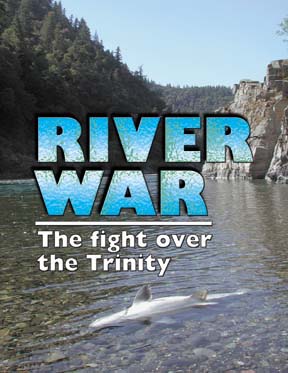
by KEITH EASTHOUSE
"Whiskey's for drinking; water's for fighting." -- MARK TWAIN THE SPRING CHINOOK LAY BELLY-UP IN SHALLOW WATER, bobbing up and down rhythmically as if the Trinity River had rocked it gently to sleep. But this, clearly, was not sleep. "It was coming back up the river. It would have spawned in September," said Mike Orcutt, senior fisheries biologist with the Hoopa Valley Tribe. [photo below right] Looking down at the silver-white fish on a sunny July morning, the water appeared clear as glass. But looking out at the river itself, the water, through the trick of light refraction, appeared blue-green. It looked almost tropical. Orcutt and his two passengers piled into a steel-hulled boat and moved out into the current. Within minutes the craft scraped bottom. The harsh grating sound surprised a flock of turkey vultures that had been feeding on something on the bank -- another dead salmon? 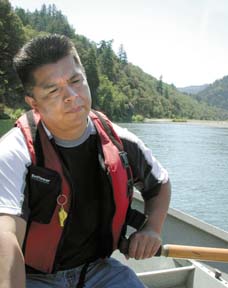 Orcutt said he first heard reports of dead fish in the river a few weeks before. "It happened last year, too," Orcutt said, adding that it's not clear what's killing them. Rising water temperatures, always a problem in the summer, may be making them more prone to disease or parasites. Orcutt said it's possible nothing out of the ordinary is going on, that the "pre-spawning mortality," as he put it, is simply more noticeable because the salmon run this spring was sizeable. Orcutt said he first heard reports of dead fish in the river a few weeks before. "It happened last year, too," Orcutt said, adding that it's not clear what's killing them. Rising water temperatures, always a problem in the summer, may be making them more prone to disease or parasites. Orcutt said it's possible nothing out of the ordinary is going on, that the "pre-spawning mortality," as he put it, is simply more noticeable because the salmon run this spring was sizeable.
"The typical [mortality] level might be 1 percent per year, so if the run is big you're going to see more dead fish." Might salmon be dying because large portions of the river's flows are dammed and diverted southward, to farmers in the Central Valley? In other words, isn't the river lower -- and therefore warmer -- than it would be at this point in the summer if no diversions were taking place? Orcutt doesn't answer the question directly, perhaps because he knows that flows on the unregulated Trinity varied widely and could drop to a trickle from late July through the end of September. But he does say this: "We've created an artificial system here that may be making the fish more vulnerable." A pivotal hearing The artificial system of the Trinity River, and to what extent it should be restored to its natural state, has been under debate for more than two decades -- and there is no resolution in sight. "I don't foresee an end to this in the near future," said Tom Stokely, a planner with Trinity County and a key player in efforts to restore the river. "I'm 47 and I expect to be working on this until I retire." The latest chapter of the Trinity saga will unfold in a federal courtroom in Fresno next Tuesday, when U.S. District Court Judge Oliver Wanger hears arguments in a case that is widely viewed as pivotal to the future of the Trinity River. At issue is a lawsuit filed in late December 2000, just days after then-Interior Secretary Bruce Babbitt signed a years-in-the-making restoration plan for the Trinity. More water for the Trinity lay at the heart of the plan. Babbitt ordered that no more than 52 percent of the river's water could go to the Central Valley -- a significant drop from the 75 percent that had been diverted for much of the 1980s and 1990s, and a sea-change from the 1960s and 1970s, when up to 90 percent of the Trinity was sent south every year. 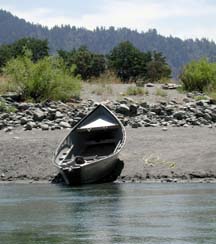 Not surprisingly, farmers fought Babbitt's order. Westlands Water District, which has used Trinity River water to develop a multibillion-dollar agricultural economy, filed a legal challenge. It was later joined by the Sacramento Municipal Utility District (SMUD), which stands to lose as much as $2 million in electricity generated by Trinity powerhouses. Not surprisingly, farmers fought Babbitt's order. Westlands Water District, which has used Trinity River water to develop a multibillion-dollar agricultural economy, filed a legal challenge. It was later joined by the Sacramento Municipal Utility District (SMUD), which stands to lose as much as $2 million in electricity generated by Trinity powerhouses.
Last year, Wanger, who has a reputation for favoring agricultural interests, applied the brakes to Babbitt's "record of decision." He said the Interior Department didn't look closely enough at how the plan might affect power generation. He also said the department didn't properly study how keeping more water in the Trinity might affect imperiled fish species in the San Francisco Bay Delta. Wanger ordered the government to fix these shortcomings. He allowed parts of Babbitt's plan to go forward -- such as projects to restore fish habitat and raise bridges downstream of Lewiston Dam to make way for higher flows. But he postponed a decision on the higher flows themselves, without which, many believe, much of the rest of the plan cannot work. It is the issue of the flows -- whether to give the Trinity more water now, as called for in the Babbitt plan, or to study the matter further, as farming and power interests are demanding -- that Wanger is expected to rule on, either at next week's hearing or shortly thereafter. Wanger has already made one decision this year regarding flow levels in the Trinity. Because last year was a drought year, he had capped the flows allotted to the Trinity at 368,000 acre-feet -- the amount allowed in a "critically dry water year" under the Babbitt plan and slightly more than the minimum the river was getting prior to the plan. Last year's limit would have remained in place this year, even though this was a normal year in terms of precipitation, were it not for the Hoopa tribe, which petitioned Wanger to give the Trinity the amount called for in Babbitt's plan in a "normal water year" -- 647,000 acre-feet of water (an acre-foot is the amount of water necessary to cover an acre of land in a foot of water). Wanger balked at that. But in a decision at the end of April, he did agree to allow an additional 100,000 acre-feet of water -- 32.5 billion gallons -- to go down the river this year, bringing the Trinity's 2002 allotment to 468,000 acre-feet. The Hoopa tribe's victory, if that's what it was, could be short-lived. SMUD has come forward with a proposal that, in the view of critics, amounts to a maintenance of the pre-record of decision status quo -- significantly lower flows than called for by Babbitt and restoration projects that rely heavily on mechanical methods, such as dredging, to improve fish habitat. Arlen Orchard, an attorney with SMUD, said Babbitt's plan is based on flawed science. "There are other [proposals] out there that provide a more balanced approach that will result in increased flows and fish restoration but at the same time will not have quite as big a detrimental effect on downstream water users," Orchard said in a recent telephone interview from his Sacramento office. Stokely of Trinity County, who was heavily involved in developing the planning documents that support the Babbitt plan, said the SMUD approach has already been studied. "It didn't cut the mustard," Stokely said. False assurances The Trinity River controversy dates back to the early 1950s, when a string of public hearings was held regarding a government plan to dam the river and send some of its water over the mountains and down into the Sacramento Valley. Irrigators supported the proposal, as did hydropower interests. Concerns were raised about the impact on the river's salmon and steelhead fishery. But then-Congressman Clair Engle, who was on the verge of making a successful run for the U.S. Senate and needed the support of California's powerful agriculture industry, assured voters in the north that "the Trinity project does not contemplate diversion of one bucketful of water which is necessary in this (the Trinity) watershed." An official with the U.S. Bureau of Reclamation, the agency that would build the dams that would make the diversion possible, went so far as to claim that the "fisheries would be improved" by the project. The 1955 legislation that created the "Trinity River Division" of the Central Valley Project, a vast water collection and power generating network that to this day is critical to the state's farming and energy interests, directed the Interior secretary "to adopt appropriate measures to ensure the preservation and propagation of fish and wildlife." The next year, the reclamation bureau told Congress that no more than 56 percent of the Trinity's water would be diverted to the Central Valley Project. Seven years later, in 1963, after the completion of Trinity and Lewiston dams and of the Clear Creek diversion tunnel, which funnels Trinity River water into a reservoir near Redding, these assurances were revealed to be nothing more than empty words. The reclamation bureau, which had just signed a water-delivery contract with the Westlands Water District in the San Joaquin Valley, promptly began diverting 90 percent of the river's water and continued to do so until the early 1980s. By the late 1960s it was becoming clear that fish populations were in serious decline. By 1977 so much water was being sent to irrigators that Trinity Lake, the reservoir formed by Trinity Dam, was drained to 10 percent of its capacity. "They hardly let water out of the dam" and into the river, recalled Stokely. "It was an extreme [water] temperature emergency. Thousands of fish were dying. It was a catastrophe." Showing that fish need water How was the reclamation bureau able to send so much water to the Central Valley and leave so little for the Trinity basin -- particularly since Congress had instructed the executive branch to protect the basin's fish populations? According to Tom Schlosser, a lawyer representing the Hoopa tribe, the answer lies in the language of those instructions. Despite all the assurances, in congressional proceedings and from politicians, that the Trinity and its fish populations would not be deprived, the 1955 act gave the bureau a virtual free hand in two ways: It allowed the agency to release as little as 150 cubic feet of water per second to the river ("a trickle," according to Schlosser); and it qualified its requirement that the fishery be protected by directing the Interior secretary to take only "appropriate measures." Schlosser said this put "on the fisheries agencies and the tribes the burden of showing what's needed to protect the fish." "The Bureau of Rec's view," Schlosser continued, "was that all we have to do is the minimum -- 150 cfs -- until you show us something else is appropriate. To go above [that] one had to show the fish needed water." Schlosser said "it took a few years" for scientists from the California Fish and Game Department and the U.S. Fish and Wildlife Service to do just that -- "and [it] took decades for the bureau to comply" and start releasing more water to the river. Byron Leydecker, founder of the group Friends of Trinity River and a vocal critic of the diversion project, said that the 90/10 diversion ratio "happened in my opinion because the bureau doesn't pay any attention to the law." He also noted that no one at the time sued. That last point jibes with something that Floyd Dominy, a retired reclamation bureau commissioner who spearheaded the Trinity project, told the Sacramento Bee in a recent interview. "Back in our day, we didn't have the naysayers," said Dominy, now 92. "We didn't have this Endangered Species Act. Everybody thought the projects were beneficial and in the national interest." Challenging the bureau Trinity County was one of the first naysayers, taking the reclamation bureau to court in the late 1970s after the near draining of Trinity Lake and the fish debacle. 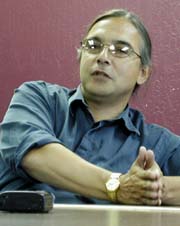 Another was the Hoopa tribe, which became incensed after Indian fishermen were blamed for the crashing fish populations. And not just blamed. "The Indian fishermen who continued to exert their right to fish got pounded into the sand and were arrested by federal marshals," recalled Clifford Lyle Marshall, chairman of the Hoopa Valley Tribal Council [photo at left]. A subsequent, three-year government study found that Indian fishing was having a minimal impact and identified three reasons for the disappearance of the fish: the diversion of water from the dams, erosion from logging and overfishing in the ocean. "We were exonerated in three years," Marshall said. "That was the first battle. After that, we decided we wouldn't get caught again without our own science." Another was the Hoopa tribe, which became incensed after Indian fishermen were blamed for the crashing fish populations. And not just blamed. "The Indian fishermen who continued to exert their right to fish got pounded into the sand and were arrested by federal marshals," recalled Clifford Lyle Marshall, chairman of the Hoopa Valley Tribal Council [photo at left]. A subsequent, three-year government study found that Indian fishing was having a minimal impact and identified three reasons for the disappearance of the fish: the diversion of water from the dams, erosion from logging and overfishing in the ocean. "We were exonerated in three years," Marshall said. "That was the first battle. After that, we decided we wouldn't get caught again without our own science."
The county and the Hoopa tribe, along with the Yurok Tribe, which has land northwest of the Hoopa reservation, were instrumental in persuading Cecil Andrus, Interior secretary under President Carter, to order, in 1981, that a 12-year "flow study" be undertaken to determine how much water would be needed to rejuvenate the fisheries. The county and the tribes also played a critical role in pushing Congress to pass, in 1984, legislation that mandated "restoration of fish and wildlife populations levels to those which existed immediately preceding construction of the Trinity Division." The problem back then, and to this day, was that there never was enough water given to the Trinity to accomplish the goal of restoring fish populations. For example, Andrus, in a foreshadowing of Babbitt's plan, directed that water flowing into the river be increased by varying amounts. But his mandated flow increases never took place because of emerging drought conditions. Flows were finally increased in 1991, when Interior Secretary Manuel Lujan, in response to a petition from the Hoopa tribe, ordered that the minimum flows in the river be increased to 340,000 acre-feet. The next year, the 1992 Central Valley Project Improvement Act ordered the Interior secretary to determine by the end of 1996 the flows required to restore the river. Babbitt missed this deadline, finally meeting it four years later at the tail end of the Clinton administration. Failed restoration In the 1980s, a new phase began in the Trinity fight, one that centered on projects to restore the river's fish populations. To understand these projects, it is first necessary to understand the extent to which the Trinity, which once offered superb spawning and rearing habitat, had become inhospitable to fish. First and foremost, the two dams completely blocked access to the best the river had to offer -- over 100 miles of cold water salmon and steelhead habitat above the two dams. That forced the lower river, in particular the 40-mile stretch below Lewiston Dam, to take on the role of providing salmon and steelhead with the habitat they need to grow when they are young and spawn when they reach the end of their life cycle. It was originally thought that the loss of the upper Trinity could be compensated for by installing a fish hatchery at the Lewiston Dam -- and to some extent this has been proved true. According to Joe Polos, a fisheries biologist with the U.S. Fish and Wildlife Service, the hatchery has been "integral in sustaining downstream populations. In some years a majority of the fish spawning in the river are hatchery-produced," Polos said. But while the hatchery has helped prevent Trinity salmon and steelhead from disappearing altogether, it has not made possible healthy populations. While there is not extensive data on predam fish populations, Polos said the best scientific estimate is that fish populations on the Trinity today have declined about 90 percent from what they were when the river was wild. The reason the hatchery hasn't had more of an effect is simple -- dumping more fish into the river didn't address the habitat problem. The diversion has robbed the river of the high flows that scour out the channel and form the cool, deep pools preferred by the fish. iPredam peak flood levels were as high as 100,000 cubic feet per second. Today, the highest flows from the Lewiston Dam are on the order of 6,000 cubic feet per second. Several things have happened in the absence of powerful floods, most notably the creation of what are known as "riparian berms." The natural Trinity would move back and forth horizontally depending on how much water was in the river, creating back channels that were ideal for young fish to hang out in and grow before they move down the river and into the ocean. When the flows dropped permanently because of the diversion, those back channels disappeared. Even worse, willow seedlings and other vegetation that used to get routinely swept away by high water now had nothing to block their growth. The river got "channelized," as Scott McBain, an Arcata-based consultant who is an expert on river restoration, put it. Many of the restoration projects have focused on mechanically removing the vegetation armoring the banks. According to Leydecker, a vocal critic of the restoration effort, the majority of the projects failed for a simple reason: The flows weren't large enough to prevent a new generation of vegetation from re-establishing itself. Another type of restoration work has to do with addressing the fact that many of the gravels that are ideal for spawning are intercepted by the dams and never make it to the lower river. The solution has been to dump gravel at strategic locations. Here again the results have been less than successful and for the same reason -- not enough water, in this case to transport the gravel downstream. Leydecker is concerned that history is going to repeat itself. Babbitt's plan calls for more than 40 restoration projects over the next seven to nine years on the part of the river below the Lewiston Dam. Judge Wanger has ruled that those projects can go forward. If they do go forward, but without the flows designated by Babbitt, Leydecker said the restoration effort will continue to be futile -- and might very well be harmful. "If they're going to be running tractors around in there in the absence of water, I'm concerned they're going to ruin the damn river." Doug Schleusner, the reclamation bureau official who is heading up the restoration work, acknowledged that getting the flows Babbitt called for is important. But he said that the restoration program will be flexible and will adapt as needed. "If it turns out the science says we can't reliably expect the flows to be sufficient, then we wouldn't go that way. If we do believe we have enough water going down the river, then maybe this is an opportunity to test our restoration techniques." Schleusner said that there are some projects, such as certain "gravel introduction" efforts, that can "proceed regardless of flows." McBain said the 12-year flow study that was initiated in the 1980s has already shown that the flows the river has been getting aren't sufficient to allow the restoration work to be successful. He said it's an open question whether the flows Babbitt outlined will be enough.
PRE-DAM CHANNEL
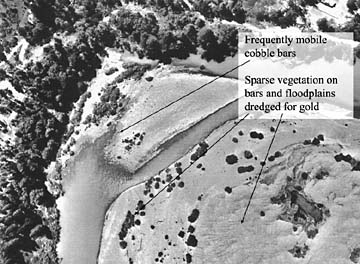 POST-DAM CHANNEL
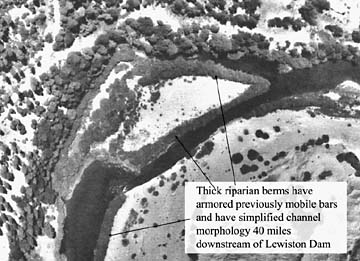 Images courtesy of McBain & Trush
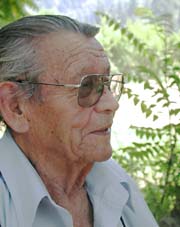 'An Indian playground' 'An Indian playground'
Like Dominy, the retired reclamation bureau czar who made the Trinity diversion project possible, Jimmy Jackson is 92 years old [photo at left]. But that's probably all he has in common with Dominy, a man considered by environmentalists to be an arch-villain for his role in a slew of dam projects in the 1950s and 1960s -- most notoriously the construction of Glen Canyon Dam, which drowned an extraordinarily beautiful and labyrinthine desert canyon in southern Utah. Jackson, an elder with the Hoopa tribe, remembers that when he was young there were "fish all over the damn place" in the Trinity. "There were a lot of deep holes" for the fish, Jackson said during an interview at his home on the Hoopa reservation. "Now all the gravel has piled up and filled all our deep holes." A lively man with a sharp sense of humor, Jackson is defiant, not defeated, when he talks of the river. "`Normal flows,' the white man calls it," Jackson said, an edge of scorn in his voice. "They cut us off and took our water. They killed our fish. That was our food." The river provided something else to the tribe, Jackson said: a sense of sacredness that is still expressed by the numerous ceremonies the tribe holds along its banks. "It's a wonderful thing, that river. It's an Indian playground. It's just like a church."
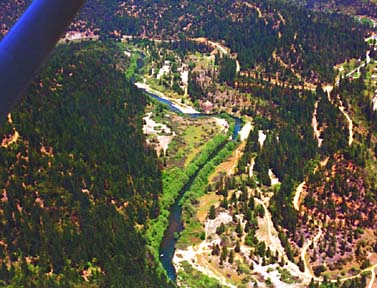
Above: aerial view of the Trinity River
Below: Map of Trinity River overview 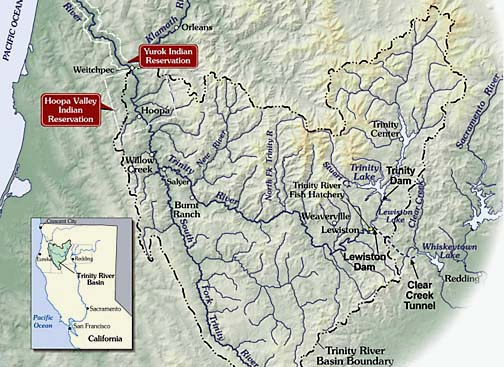
Images courtesy of McBain & Trush
IN THE NEWS | OPINION | CALENDAR Comments? E-mail the Journal: [email protected] 
© Copyright 2002, North Coast Journal, Inc. |